Last Updated on June 19, 2023
The Jason Goes to Hell episode of WTF Happened to This Horror Movie? was Written by Cody Hamman, Narrated by Jason Hewlett, Edited by Victoria Verduzco, Produced by Lance Vlcek and John Fallon, and Executive Produced by Berge Garabedian.
The first several films in the Friday the 13th franchise stuck to a very simple formula: a group of young people get together in a remote location and get knocked off one-by-one, either by iconic slasher Jason Voorhees, his mother Pamela Voorhees, or a copycat. While a couple of the films included crazy elements like Jason being resurrected by a lightning bolt or the heroine having telekinetic powers, they still retained that same basic set-up. Friday the 13th Part VIII: Jason Takes Manhattan was the first to stray from the woods in a major way, but the shake-up that saw Jason getting dropped into Times Square was nothing compared to the insanity the ninth film had in store for us. Today, we’re taking a look at 1993’s Jason Goes to Hell (WATCH IT HERE – OWN IT HERE) to try to figure out What the F*ck Happened to This Horror Movie.
Paramount Pictures had released the first eight Friday movies, but when their effort to revitalize the franchise with a trip to Manhattan turned out to be a box office disappointment, they decided to get out of the Jason business. So Sean S. Cunningham, the producer and director of the original Friday the 13th, re-emerged to take control of the franchise he had started a decade earlier. He found Jason a new home at New Line Cinema, the studio that was known as the House That Freddy Built due to the game-changing success they had with the Nightmare on Elm Street franchise. Given that Paramount and New Line had previously discussed, and then abandoned, the idea of a Freddy vs. Jason movie in the ‘80s, getting Jason set up at New Line paved the way for that crossover to finally happen… But first, Cunningham and New Line wanted to make a solo Jason film.
The filmmaker who was chosen to bring Jason to the screen this time around was Adam Marcus – quite an unexpected choice, since Marcus was a 23-year-old who had never directed a feature before. Marcus and Cunningham had a long history together, though. Marcus had been friends with Cunningham’s son Noel since they were children, and Marcus had even worked on the set of the first FRIDAY when he was just 11. By the early ‘90s, he had graduated from film school and was hoping to direct his friend Dean Lorey’s zombie comedy screenplay Johnny Zombie as his debut feature. But when the project – which would eventually be renamed My Boyfriend’s Back – was sold to Disney, it was out of Marcus’s hands and he was left without a movie to make. So Cunningham gave him the chance to make a Jason movie. There were only two conditions in place: one, Marcus was to ignore the fact that Jason Takes Manhattan ever happened. And two, Cunningham wanted him to “Get that damn hockey mask out of the movie.” Apparently he wasn’t too fond of what Jason had become since he made his cameo appearance at the end of the first Friday the 13th. Cunningham has since denied that he ever told Marcus to ditch the hockey mask, but Marcus insists that he was given this order.
When Marcus sat down with writer and former Magnum P.I. producer Jay Huguely to figure out how to separate Jason from his hockey mask, they deduced that the way to do it was to dig deep into the supernatural elements that had never been explored beyond the fact that Jason could return from the dead very easily. This time around, they were going to give him the ability to possess people as well. So the concept that Jason’s spirit would be passing from body to body throughout the film was in place from the beginning, and Cunningham and the executives from New Line gave this idea their stamp of approval early on. Details did change along the way, though. For example, the first draft of the script started by introducing Jason’s hideous, boil-covered brother Elias, a character who had never even been hinted at in any of the previous movies. Ignoring Jason Takes Manhattan as he was told, Marcus intended to pick up from the ending of Friday the 13th Part VII: The New Blood and have Jason’s corpse lying at the bottom of Crystal Lake. Elias would be shown pulling his brother out of the water, removing his heart – after a bit of a struggle, as Jason would regain consciousness mid-surgery – and then consuming the heart, thus gaining his brother’s evil powers. Body hopping shenanigans would ensue from there.
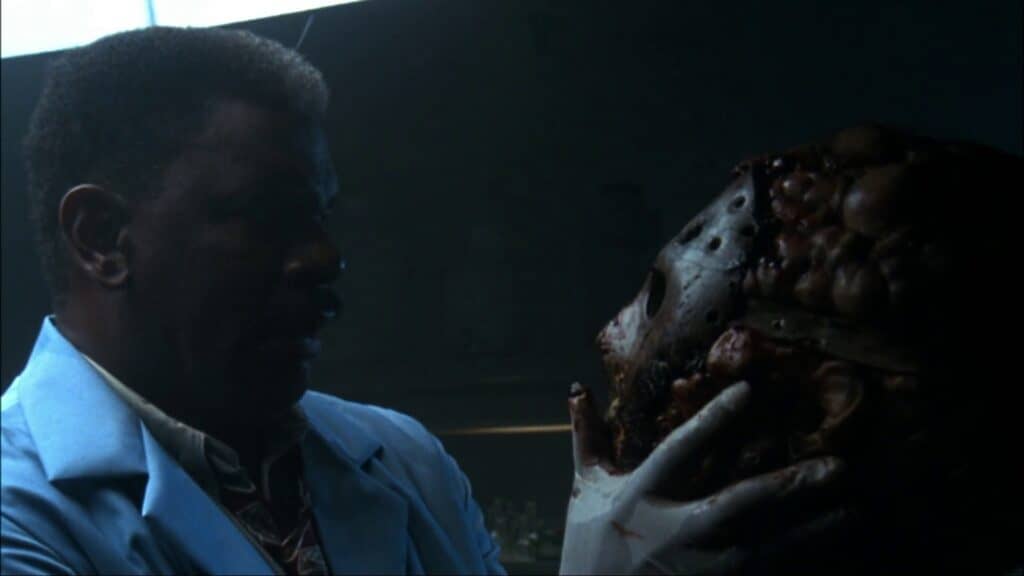
When everyone involved decided that Jason should have a larger presence in the overall story, Marcus’s friend Dean Lorey was brought in to perfect a quick rewrite. A very quick one; Lorey was hired on Thursday and told the rewrite needed to be finished on Monday. He was to do the writing in Cunningham’s office, with Cunningham sitting nearby to make sure the work got done. Lorey would have rather written a Jason Takes L.A. script about Jason getting caught between two warring gangs, but he was stuck with just trying to improve the body hopping idea. He took the Elias character out of the story, but did include a reference to the name – at one point, it’s said that Jason’s father was named Elias. He also added the fan favorite character Creighton Duke, a bounty hunter who has extensive knowledge of the supernatural abilities we never knew he had. It was supposed to be revealed in the film that Duke became obsessed with Jason after the slasher killed his girlfriend years earlier, but that explanation didn’t make it to the final cut. Lorey got the script closer to what the movie turned out to be, but he wasn’t the last writer on the project: Leslie Bohem, who had written the fifth Nightmare on Elm Street movie The Dream Child, also did revisions. And the film’s opening sequence was given a boost by the film’s armourer, Cunningham’s DeepStar Six writer Lewis Abernathy – who would later write a draft of Freddy vs. Jason. It was Abernathy who suggested Jason Goes to Hell should start with Jason getting blown to pieces.
So it does. Marcus pulls a bait and switch on the audience, starting the film in a way that makes it look like we’re in for another “cabin in the woods” sequel. A woman arrives at a cabin, presumably there on vacation, and just when she’s about to take a bath her peaceful time is disrupted by the arrival of Jason, who’s still stalking around the Crystal Lake area with no explanation given as to how he returned after the events of any previous film – because, remember, Jason Takes Manhattan apparently never happened. It’s all a set-up, though. The woman is an FBI agent who leads Jason into an ambush that ends with him getting blown up. We’re just 7 minutes into the movie and our beloved slasher has been destroyed. Lucky for him, Marcus has given him that whole possession insurance policy thing.
So Jason’s still-beating heart hypnotizes a coroner, enticing him to eat the muscular organ and become possessed by Jason’s spirit. Now Jason, in his new body that still casts a reflection of Jason in all his hockey masked glory, sets out on a mission: he has to go to Crystal Lake and locate his sister Diana – again, a sibling that had never been hinted at previously. Because, as Creighton Duke will inform us, the bodies Jason possesses break down quite quickly, and the only way he can be reborn in his own, mostly indestructible body is through a fellow Voorhees. The down side: Jason is also putting himself in danger by going after Diana – not to mention her daughter Jessica and Jessica’s baby Stephanie – because other Voorhees have the power to send him directly to Hell.
While Jason Goes to Hell comes off as being completely nuts because none of this is in line with anything we’ve heard in this franchise before, Marcus was able to assemble a good cast for this crazy movie. Kane Hodder, who had played Jason in The New Blood and Jason Takes Manhattan, was brought back to play the role for a third time. While Jason is only in his own body for the opening sequence and the climax, with some reflection appearances here and there, Hodder still had plenty to do on the movie because he was the stunt coordinator, and makes a cameo as a victim of the Jason-possessed coroner. Broadway star John Rubinstein was initially cast in the role of Creighton Duke, but when he had to leave the project he was replaced by Steven Williams, who turned in an awesome performance. Tippi Hedren auditioned to play Jason’s sister Diana, but the role ended up going to Erin Gray. Kari Keegan plays her daughter Jessica, and it isn’t until Jason kills Diana and Jessica returns to Crystal Lake for the funeral that her ex Steven Freeman, played by John D. LeMay, discovers they have a baby daughter together. Steven is the lead character in the story, he is, aside from Duke, the first to realize that Jason is rampaging through Crystal Lake in other people’s bodies – and Marcus had originally intended for this character to be Tommy Jarvis, the hero from the fourth, fifth, and sixth movies. But Marcus was told that he couldn’t use Tommy because the character was owned by Paramount, so he was changed to Steven Freeman. Paramount also held on to the title Friday the 13th, which is why the movie was called Jason Goes to Hell: The Final Friday. Final? Yeah, sure. We’ve heard that before.
Other notable characters in the film are played by Allison Smith, Richard Gant, Billy Green Bush, Rusty Schwimmer, Leslie Jordan, Steven Culp, Adam Marcus’s brother Kipp Marcus, Julie Michaels, Adam Cranner, and Andrew Bloch. Several of those characters are possessed by Jason at some point in the film – and the strangest possession scenes comes when Richard Gant’s coroner passes Jason’s evil spirit, in the form of a worm-like creature that exits one person’s mouth and enters the other person’s mouth, to Andrew Bloch’s character Deputy Josh. Before the coroner baby-birds the evil worm into Josh, he strips the man down, straps him to a table, and shaves off his mustache. Now, we see the coroner doing this stuff, but it’s supposed to be Jason doing it, and we’ve never seen Jason do anything like this before. Why does Jason strip Josh and shave him before possessing him? There’s absolutely no reason for it within the film, Marcus just knew that seeing this would make audience members uncomfortable.
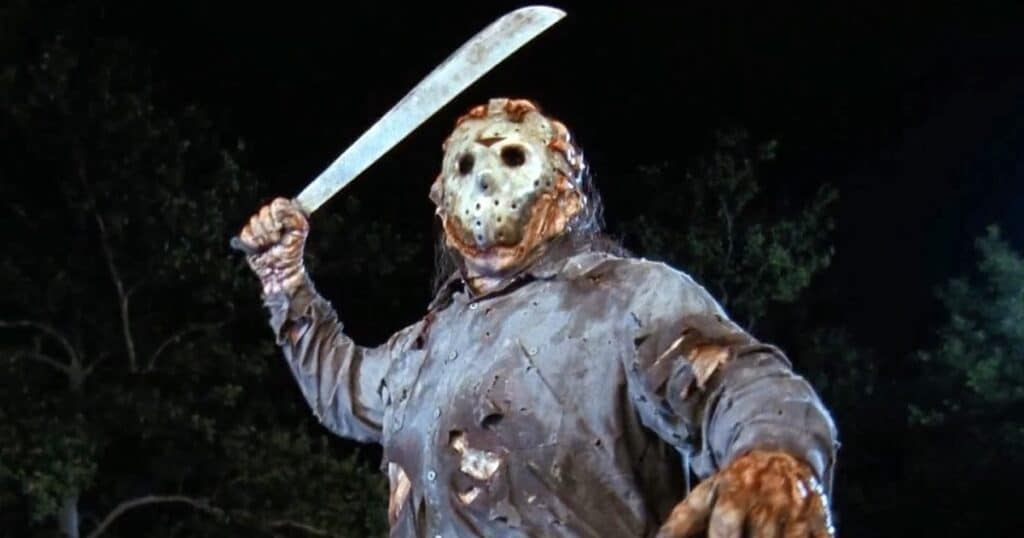
While he was working to make people uncomfortable, Marcus also imagined that he was building a cinematic universe – long before Marvel, but well after the Universal Monsters collided with each other and Abbott and Costello. He includes references to several other films in Jason Goes to Hell, including a line about “the Myers place”, putting a jungle gym that was seen in The Birds in front of the Voorhees house, placing the crate from Creepshow in the basement of the house, having script supervisor Harri James reprise the role of a police officer she had played in Die Hard, and sticking the Necronomicon from The Evil Dead inside the Voorhees house. The Necronomicon was the most important Easter egg of the bunch, and Marcus acquired the book from Sam Raimi while visiting the KNB effects crew on the set of Army of Darkness. As far as Marcus was concerned, putting the Necronomicon in Jason Goes to Hell explained exactly why Jason has supernatural abilities. While he couldn’t directly state this in the movie due to rights issues, he believed that Pamela Voorhees had used the Necronomicon to resurrect Jason after he drowned as a child. That’s why he could always return from the dead, and why he’s able to possess people now: he is a variation of the Evil Dead franchise’s Deadites.
Of course, the most famous reference to another franchise in the movie is the appearance of Freddy Krueger’s gloved hand, which shows up at the end of the movie to drag Jason’s hockey mask down to Hell after demon hands have burst out of the ground and done the job of getting the rest of him down there. Jessica makes that happen by sinking a magic dagger into Jason’s heart – a dagger that happens to be another Evil Dead prop.
After production wrapped, Marcus got a cut of Jason Goes to Hell ready to be shown at a test screening – and when that screening was over, it was clear that the movie was lacking something. Not only were there no horny youths taking mind-altering substances in Jason Goes to Hell, as Marcus wanted to center his film on adult characters dealing with more serious issues, but the first cut also didn’t feature a single camper, unless you count the woman at the cabin who turns out to be an FBI agent. Audience members and New Line Cinema had a request: Marcus had to fit in a scene where Jason kills campers.
So Marcus and his crew went back to work to do reshoots and put together a new cut of the movie. Scenes were reworked; extra moments with Creighton Duke were filmed in an effort to make the new rules of Jason’s abilities easier to understand; at least one jump scare was a late addition; a character played by future multiple-season Survivor contestant Jonathan Penner was cut out. A shot that shows a little demon called the Hellbaby, which emerges from a decapitated possessed character, going up the skirt of Diana’s corpse, thus allowing for Jason to be reborn, was another studio demand, but a moment in which the characters are faced with a much larger version of the Hellbaby, played by a performer in a full-body costume, was removed. And yes, campers were added in. Marcus gave New Line and Friday fans three campers to see get slaughtered, and these campers – played by Michelle Clunie, Michael B. Silver, and Kathryn Atwood – happily admit that they’re going to Crystal Lake to smoke some dope and have some premarital sex now that Jason has been blown up by the FBI. But Jason is there to ruin the celebration, and Clunie’s character is the recipient of one of the most spectacular deaths in the entire Friday the 13th franchise. These reshoots were totally worth it.
To see Clunie’s death scene in full, you have to watch the unrated cut of Jason Goes to Hell. The existence of that cut was a great marketing move on the part of New Line, because it was well known that the ratings board had done their best to make filmmakers whittle much of the bloodshed out of previous sequels. They struck again on Jason Goes to Hell, making Marcus cut his movie down substantially to achieve an R rating for the theatrical cut. But when it came time to put the film out on home video, New Line released both the R-rated theatrical cut and the unrated cut, which features a lot of incredible gore courtesy of KNB.
Unfortunately, one effect we don’t see in either cut of the film is Jason’s unmasked face. An unmasking moment was something fans had come to expect from these films, Jason’s mask was removed at some point during each one of his previous killing sprees, but it remains firmly attached to his face in Jason Goes to Hell. In fact, the mask is sinking into his face and his flesh has started to grow around the edges of it. Cunningham may not have wanted the hockey mask to be in the movie very much, but when it was in the movie he did not want it coming off of Jason’s face. As he told Marcus, “The minute you see the face of fear, it’s no longer scary.”
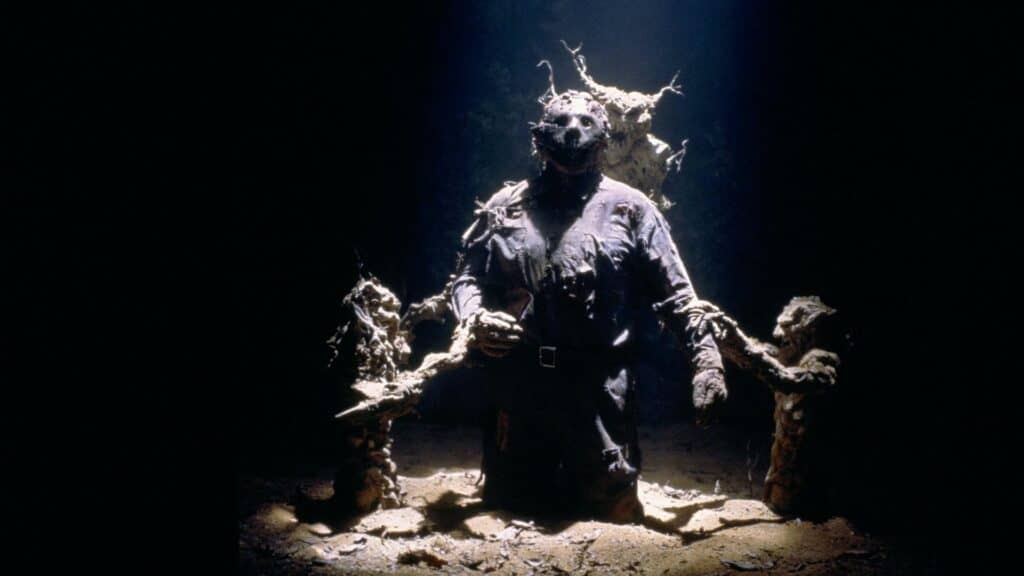
With a thirty-seven day shooting schedule, counting the reshoot days, Jason Goes to Hell was made on a budget of two-point-five million dollars. Released to theatres on August 13th, 1993, it had a seven-point-six million dollar opening weekend and ended up with a final domestic haul of fifteen-point-nine million dollars. Not terrible for the budget, but it certainly wasn’t a hit. It did only slightly better than Jason Takes Manhattan, which had underperformed so badly that it made Paramount give up on the franchise. Maybe audiences needed a break from Jason after seeing so much of him in the ‘80s, but you have to wonder if Jason Goes to Hell might have done better if Marcus hadn’t attempted to do something so different from the films that had come before. If someone did want to see more Jason, they’d be much more likely to go to the theatre to see him kill more campers than they were to see him go to Manhattan or possess people.
Cunningham and New Line tried to do something different with the franchise again nine years later, sending Jason to space in JASON X. That didn’t go over well, either. Jason didn’t deliver a hit for New Line until 2003, when he finally fought Freddy, a battle fans had been waiting to see since the ‘80s. Six years after that, there was more success when Jason was finally taken back to the woods to kill more campers in 2009’s Friday the 13th.
But while Jason Goes to Hell is certainly a black sheep in the Friday the 13th franchise and a lot of fans hate it for how different it is and for the changes that were made to the Jason character, there are also a lot of fans who appreciate its uniqueness and can go along with the idea that Jason possess people – and that he can turn into a demon worm if his body sustains too much damage. Love it or hate it, it definitely brought something new to the table, you can’t say it’s nothing but the same old thing. And we have to admit, Adam Marcus solved the problem of needing to remove the hockey mask from most of the movie in a way that probably no one else would have thought to.
To see more episodes of WTF Happened To This Horror Movie?, head over to our JoBlo Horror Videos YouTube channel – and subscribe while you’re there!







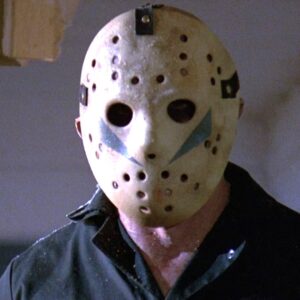

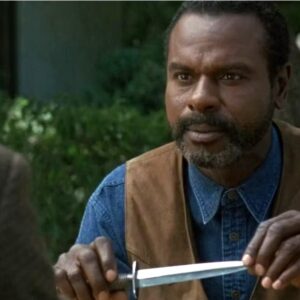
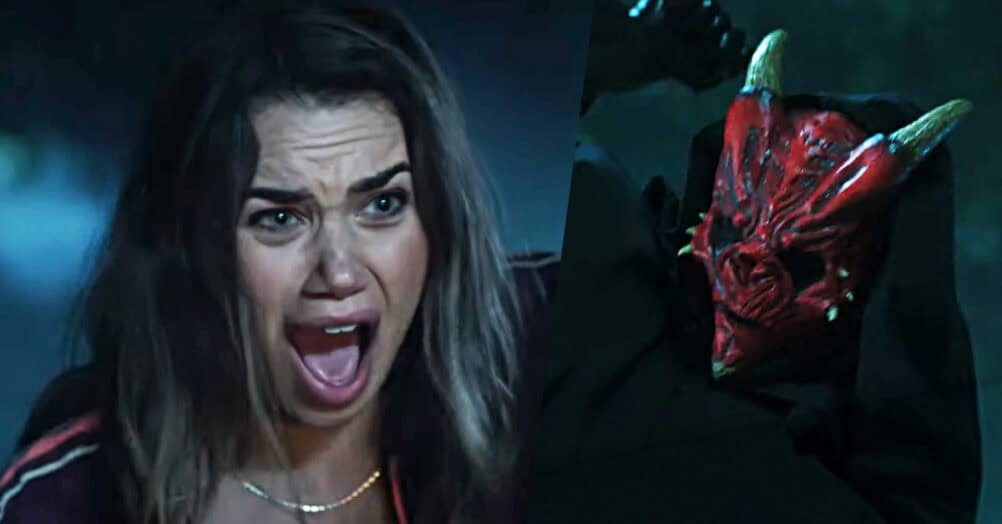



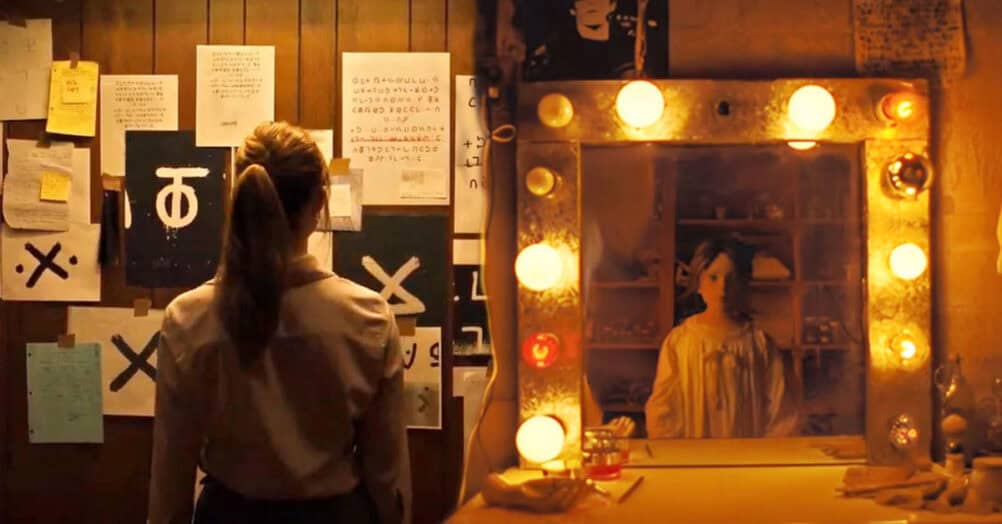
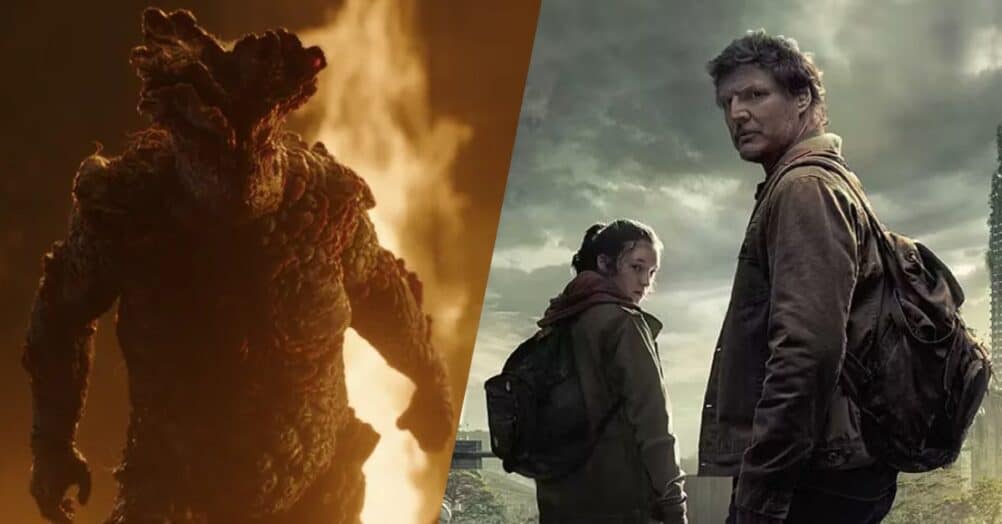


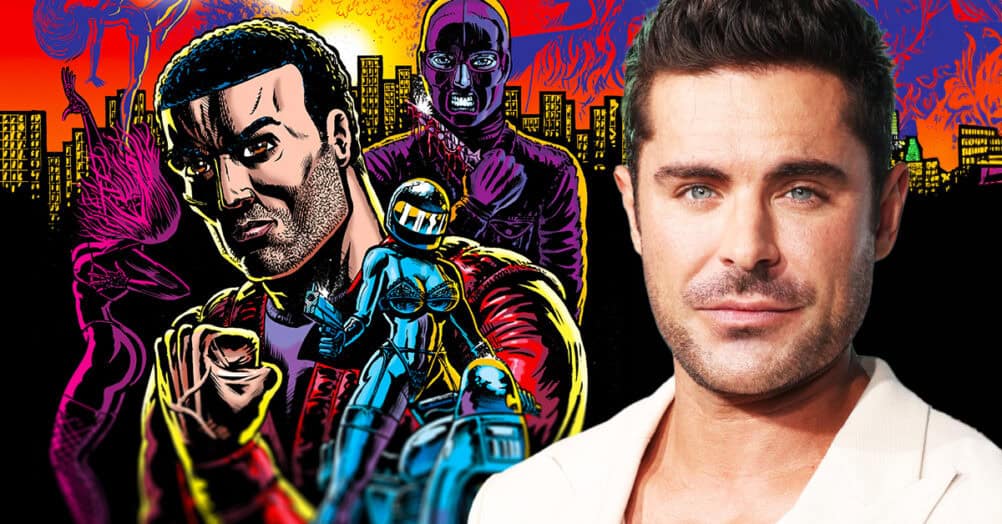

Follow the JOBLO MOVIE NETWORK
Follow us on YOUTUBE
Follow ARROW IN THE HEAD
Follow AITH on YOUTUBE